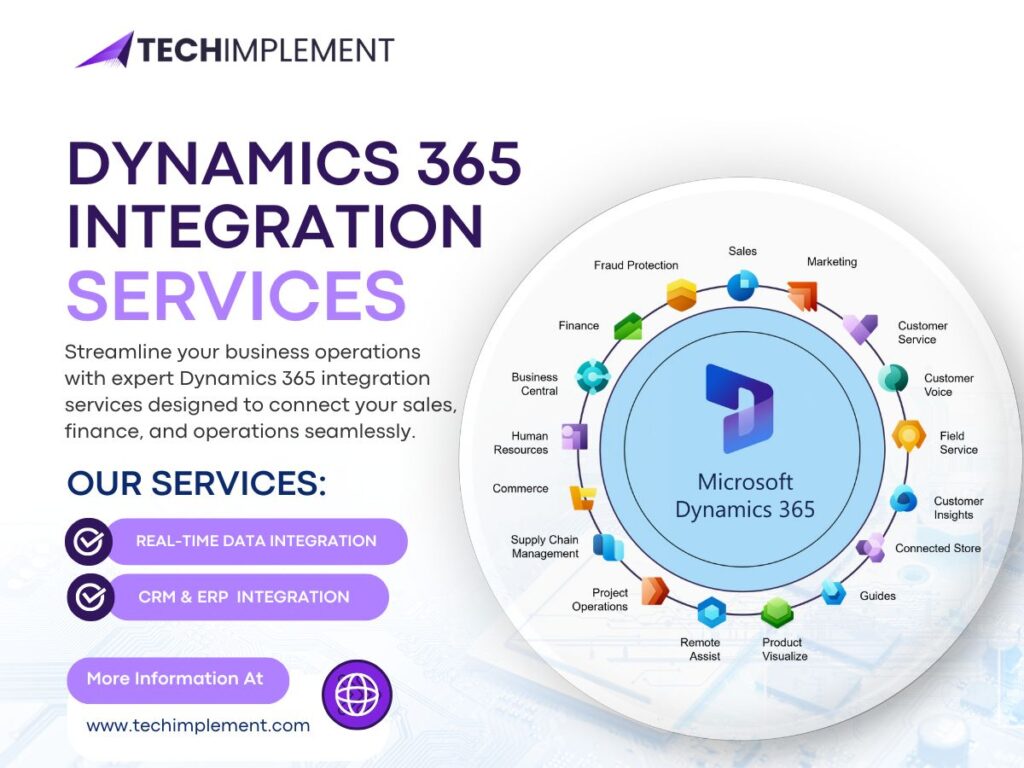Businesses today operate in an ecosystem of multiple tools, platforms, and systems. Managing data across different applications can be frustrating, time-consuming, and prone to errors. This is where Microsoft Dynamics 365 integration comes into play. By connecting Dynamics 365 with other business systems, organizations can streamline operations, improve data accuracy, and drive better decision-making.
In this post, we’ll dive into what Dynamics 365 integration is, why it’s critical for businesses, common pain points it solves, and real-world benefits.
What is Dynamics 365 Integration
Dynamics 365 is a suite of cloud-based business applications that combines CRM (Customer Relationship Management) and ERP (Enterprise Resource Planning) capabilities. Integration refers to connecting Dynamics 365 with other tools, such as:
- Accounting software (QuickBooks, SAP, etc.)
- Marketing platforms (Mailchimp, HubSpot, etc.)
- E-commerce platforms (Shopify, Magento, etc.)
- Other Microsoft solutions (Power BI, SharePoint, Teams)
The goal is to unify data, automate processes, and eliminate silos, so your team can access the right information at the right time without manual effort.
Why Dynamics 365 Integration Matters
Eliminate Data Silos
When your sales, finance, and operations data are scattered across multiple systems, you risk errors, duplication, and delayed decisions. Integration centralizes data, ensuring everyone works from the same accurate information.
Boost Productivity
Manually moving data between systems is tedious. Automation via Dynamics 365 integration reduces repetitive tasks, letting your team focus on value-driven work like sales growth and customer service.
Enhance Customer Experience
With integrated systems, customer-facing teams get a 360-degree view of each client. From purchase history to service requests, your team can respond faster and more effectively.
Real-Time Reporting and Insights
Integrated systems feed Dynamics 365 dashboards and reports in real-time. Business leaders can spot trends, identify bottlenecks, and make informed decisions immediately.
Scalable and Flexible Growth
As your business grows, integration ensures your systems scale without creating chaos. Adding new apps or departments becomes seamless, keeping workflows efficient.
Common Business Pain Points Solved by Dynamics 365 Integration
Many companies face challenges before integration. Here are some key pain points and how integration addresses them:
| Pain Point | How Integration Helps |
|---|---|
| Manual data entry | Automatic data syncing reduces errors and saves time. |
| Inconsistent customer information | Unified CRM ensures a single source of truth. |
| Slow reporting | Real-time dashboards provide instant insights. |
| Multiple systems causing confusion | Centralized workflows streamline operations. |
| Delays in financial reconciliation | Finance modules automatically update across systems. |
Types of Dynamics 365 Integration
Depending on business needs, Dynamics 365 can be integrated in different ways:
Native Integration: Microsoft offers built-in connectors for tools like Power BI, Outlook, and SharePoint. These are easy to set up and maintain.
Third-Party Integration Tools: Platforms like Zapier, KingswaySoft, or Scribe help connect Dynamics 365 to non-Microsoft applications.
Custom API Integration: For highly specific workflows, businesses can use Dynamics 365 APIs to create custom integrations tailored to their processes.
Real-World Example of Dynamics 365 Integration
Consider a growing e-commerce company that uses Shopify for online sales and Dynamics 365 for CRM and finance. Before integration, sales data had to be exported manually, causing delays and errors.
After integrating Shopify with Dynamics 365:
- Orders automatically sync with Dynamics 365 Finance.
- Inventory updates in real-time.
- Customer data flows seamlessly to marketing and support teams.
The result? Fewer mistakes, faster customer responses, and better decision-making.
How to Implement Dynamics 365 Integration Successfully
- Identify Integration Needs – Determine which systems must communicate and what data should flow between them.
- Choose the Right Integration Method – Use native connectors, third-party tools, or APIs based on complexity and budget.
- Map Data Fields – Ensure data formats match across systems to avoid errors.
- Test Thoroughly – Run pilot tests to catch any sync issues before full deployment.
- Monitor and Optimize – Regularly check the integration to ensure it continues meeting business goals.
Conclusion
Dynamics 365 integration is no longer a choice for businesses looking to stay competitive; it’s required. By connecting your CRM, ERP, and other systems, you eliminate data silos, reduce manual work, and gain real-time insights that drive smarter decisions. Whether it’s improving customer experiences, streamlining operations, or supporting scalable growth, integration ensures your business runs efficiently and effectively.
Taking the step to integrate your systems today means fewer errors, faster workflows, and a stronger foundation for future success. Don’t let disconnected systems hold your business back—embrace Dynamics 365 integration and unlock your organization’s full potential.

